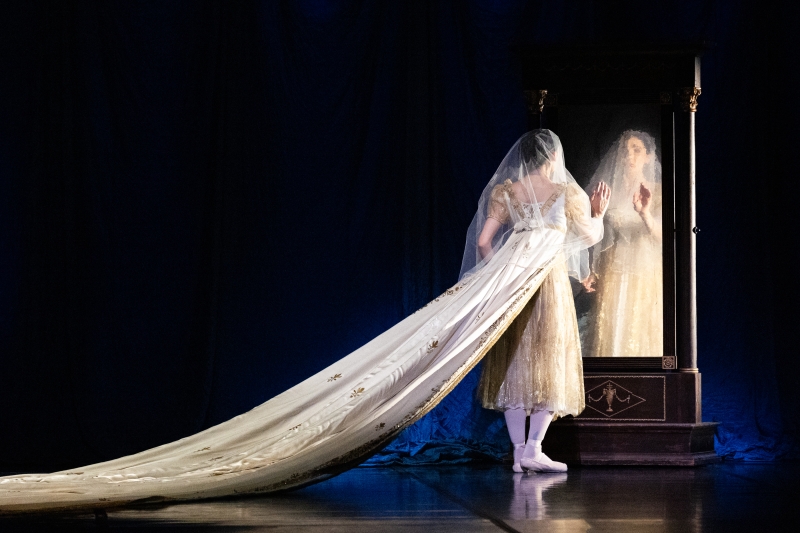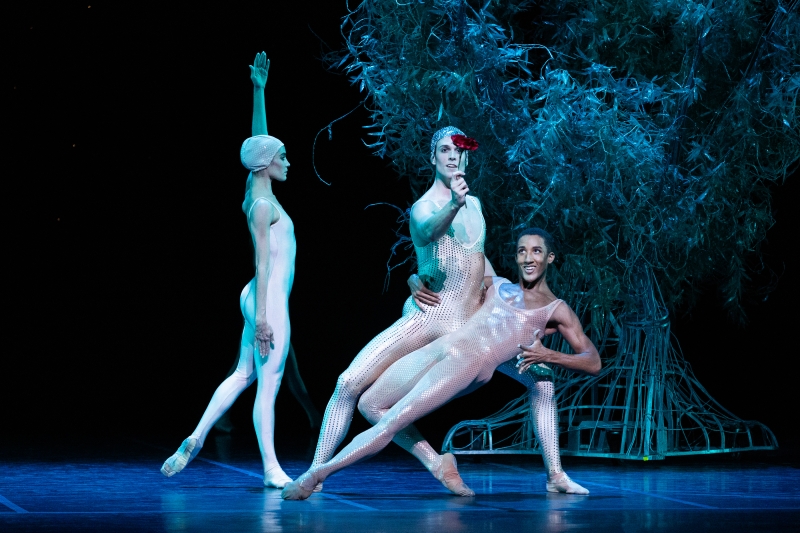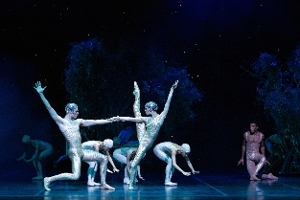Interview: Chase O'Connell Shares the Spectacle That We Can Look Forward to in Houston Ballet's MIDSUMMER NIGHT'S DREAM
This show runs through this weekend; you will not want to miss it!


as Lord Capulet With Artists of Houston Ballet
in Stanton Welch’s Romeo and Juliet.
Photo by Lawrence Elizabeth Knox(2023).
Courtesy of Houston Ballet.
The Houston Ballet's 2023-2024 season is starting off with John Neumeier's A Midsummer Night's Dream, based on Shakespeare's joyful romantic comedy of the same name. Houston Ballet was actually the first North American ballet company to perform this work! The ballet portrays the consequences of a well-intentioned plan involving a love potion, leading to hijinks and hilarity. Interwoven romances form the central theme, taking the audience on a journey from the court of Athens to a whimsical Fairy Realm.
I had the chance to speak with Chase O’Connell, one of the dancers portraying Theseus/King Oberon in Midsummer Night's Dream's run. He gave me some insight about his journey as a dancer, how it is to play opposite his wife onstage, and the spectacles within the show that we can look forward to!
To start us off, can you tell us a little bit about yourself? What is your history with dance and the Houston Ballet?
My name is Chase O’Connell. I grew up dancing; I started when I was two years old. I had an older sister who also did ballet. At 13 years old, I moved to Washington D.C. on a ballet scholarship for three years. Then at 16, I moved to London for two years, and later, I did a 6-month contract with Paris Opera. Then, I was at Ballet West for 10 years, and I've been at Houston Ballet for 1 year.
You have such an amazing resume. I have to ask, what has been your favorite Houston Ballet show to be a part of and/or what has been your favorite role to play throughout your time with the Houston Ballet?
That’s hard. I got to do a lot last year. I think one of my favorite ballets from last year was Red Earth by Stanton Welch. It was just so much fun and so demanding!
I have been told that you are a principal dancer in Houston Ballet’s A Midsummer Night’s Dream. Can you tell us a bit about the show, its story, and your role within it?

in John Neumeier's A Midsummer Night's Dream.
Photo by Lawrence Elizabeth Knox (2023).
Courtesy of Houston Ballet.
It starts off the night before a wedding; it’s an arranged marriage, so they don't really know each other before meeting. My character is not very interested in the arrangement. He's a party boy. However, the woman who he is about to be married to is hopeful that this is going to be a great marriage. She is disappointed when she first meets up with her soon-to-be husband; she’s not into it. So, she dreams that night of being the queen of the fairies, and audiences will see that her husband (who I am) is the king of these creatures. She dreams that this king and queen are in some sort of battle, and it is because she feels that she and the man she is about to be married to are at war. By the end of the act, everything is figured out, and when she wakes up, she finds that she is in love with him, and he is now in love with her. So, in the end, they are actually in love with each other, and they get married.
Created in 1977 on Hamburg Ballet, A Midsummer Night’s Dream is one of choreographer John Neumeier’s most famous works performed by companies around the globe. What was it like working with Neumeier, a celebrated and internationally renowned choreographer?
He was amazing; he had so much detail. He explained that every time he does the ballet, he wants to get better and better. It’s not like, this is what it is when I created it 40 years ago, and that is exactly how it is supposed to be. He wants to make this story resonate more. He wants the audience to understand even more every time, so he makes tweaks that he believes audiences and dancers will appreciate.
So, this show was first performed at the Houston Ballet in 2014. Do you happen to know if this production is the same to Houston Ballet’s earlier production? How did you make this story and your character your own?

First Soloist Harper Watters as Puck,
and Demi Soloist Estheysis Menendez
in John Neumeier's A Midsummer Night's Dream.
Photo by Lawrence Elizabeth Knox (2023).
Courtesy of Houston Ballet.
I believe that Neumeier focused on the audience understanding the rose, the potion, and the effect that it has on people. So, we worked on it for an hour because I demonstrate to Puck how to use the rose and how it affects the person it's used on.
Why is it important that this production is being performed today?
I think even though this ballet was originally devised in the 70s, it's still a very relevant story and relevant ballet. It was very ahead of its time choreographically-wise. It's a very hard ballet, and it's very demanding. It is great for the entire company because everyone is dancing. It's not just two people, but the whole company gets to be in the story. For the audience, it’s a half-classical, half-contemporary piece, so you hang out in the mix of both worlds, and you get to experience that all in one night.
What does a typical day of rehearsal look like for you for this production?
We have class from 10:00 to 11:15 am, and then we have a 15-minute break. Then, we’re working on the triple bill (that’s happening in two weeks after Midsummer; I am in the world premiere of Delmira by Annabelle Ochoa) for the first three hours. Then, the afternoon is three hours of Midsummer.
How was it like when Neumeier was here?
When Neumeier was here for a week, we had our fairies in one room, our lovers in another room, and more characters in another room, and he would pop in and out of each room and see what was going on. He would stay for a couple of hours in one studio and move around, so we all got to experience him.
How big of a cast does this production have?
I would say at least sixty people. Actually, probably more because there are some kids in the second act.
I was told that your wife Beckann is in the production. What is her role in this show, and how is it like to perform with a partner onstage?

and Chase O’Connell as Oberon,
First Soloist Harper Watters as Puck
with Artists of Houston Ballet
in John Neumeier's A Midsummer Night's Dream.
Photo by Lawrence Elizabeth Knox (2023).
Courtesy of Houston Ballet.
We are the engaged couple in the ballet who end up getting married at the end. It’s a lot of fun. I feel like we're very lucky that we get to experience this art form together. When you perform together, you get these magical moments.
Are there any technical spectacles or design elements in this production that we can look forward to?
Definitely! The fairy world is very different than what you imagine. There are trees, smoke, weird music… It’ll definitely be something you are not used to!
What is your favorite part to perform and/or see in the production?
I think the fairy world is my favorite part to perform. It's more contemporary. It includes some extremely hard lifts, but it's a lot of fun. I feel like you work so hard on it, so it's so rewarding when it goes right.
Speaking of lifts, what do you think is the most difficult part of the show to dance?
There are a couple of hard sections in the fairy world. It’s not to live music; it is rather to recorded music. There are also no counts. It is all visual. So, when I see someone do something do this one step, I then go on stage and do my thing. So, you're not backstage counting, going over things. Therefore, each move could last for a different amount of time every night.
Midsummer Night's Dream was my first Shakespearean show, and I found it to be a very good show to learn Shakespeare. It's one of those texts that seems to be a classic story that is not intimidating for audiences of all ages to follow. Do you feel the same way? Do you believe that this is a good show for new audience members?
I feel like it also just has everything. There's drama, there's comedy, there's classical dance, there’s contemporary dance, and there's character dancing. So, I think you get it all. Also, I feel that the comedy is really funny in this ballet. The whole mix-up with the lovers plays really well, and so I think it is great for all audiences.
To finish us off here, when and where can we see Houston Ballet’s “Midsummer Night’s Dream”?
Midsummer Night's Dream opened September 8th, and it runs through the 17th. So, you can catch it at one of the seven shows at the Wortham Theater!
You can buy your tickets for this magical production here! Tickets start at only $25.
Comments

Videos
.png)